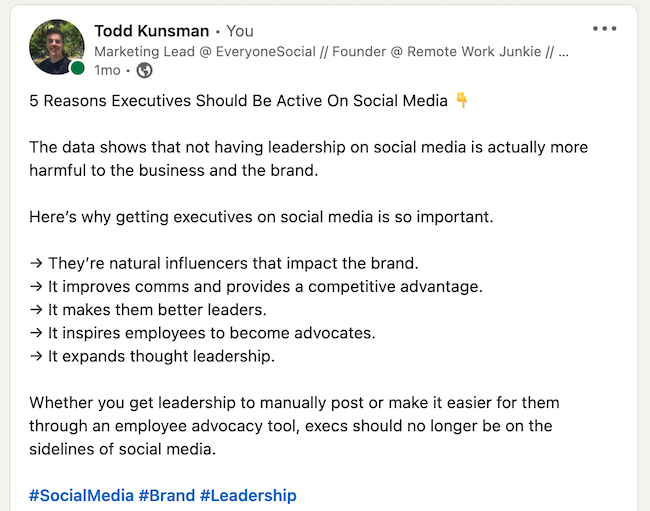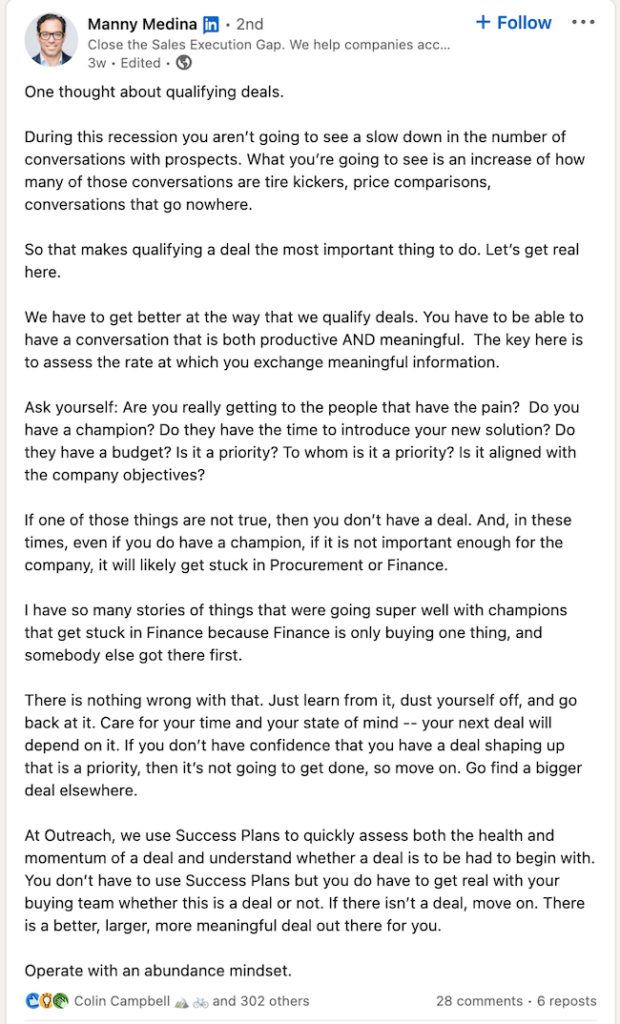I think we can all agree that LinkedIn is the professional social network that helps drive sales, retain customers, build brand affinity, and attract top talent to open job positions.
Yet we still see LinkedIn content strategy poorly executed or even neglected today.
If you want to drive real growth through this social network, there are ultimately three main ways to do that:
- Employees
- Founders/Execs
- Company Page
Below, I’ll get into the strategy behind each of these, complete with tips and examples to ensure you have a strong LinkedIn content strategy going forward. Let’s dive in!
1. Activate Employees
If you lead social media for your organization, then you’re likely familiar with employee advocacy or have at least heard the term before.
The concept is simple: It’s all about enabling employees to be social, so they can drive attention both to the company and to their own personal brands.
A few years ago, that would give every company a heart attack.
For quite some time, the train of thought was, “No way are we going to let employees have access to social media at work. What if they say something that reflects poorly on the brand!?”
Sure, there are probably plenty of company executives that STILL think that today. But it’s outdated thinking, especially given how today’s buyers conduct product research.
In fact, more than 90% of B2B buyers and more than 80% of senior executives use social media for research before making purchasing decisions.
Why should employees be in your social strategy?
Social platforms will always prioritize the individual, whether you’d like to think that or not. Mostly because:
- User growth is important to these platforms, so they want people on the platform engaging with people they know.
- People prefer to learn and engage with real humans over brands.
- This is how social platforms get ad revenue. In other words, your company has to pay for its content to appear in people’s feeds.
Now, company pages are definitely still important and impactful (see below), but individuals outperform them. And unfortunately, the majority of B2B companies have weak company page Linkedin content strategy.
Luckily, you can tap into the power of individuals by encouraging your people to create, share, and engage with content on social media. Ingrain this into your culture, lead by example, make social media a part of the onboarding process for new hires, and provide resources, training, and the right tools.
Everyone in your org has an influence and has expertise/experiences to share. Let them do it, or get left behind as employees at your competitors dominate the social feeds.

Need some convincing?
Skeptical? Or maybe you get it, but would love to see some data to back it up?
We’ve got you covered. Here’s a sample of some data around the value of employees on social media
- Content shared by employees receives 8x more engagement than content shared by brand channels. (Social Media Today)
- Leads developed through employee social marketing convert 7x more frequently than other leads. (Marketing Advisory Network)
- People are 71% more likely to make a purchase based on a social media referral. (HubSpot)
- Companies with a successful employee advocacy program are 58% more likely to attract — and 20% more likely to retain — top talent. (LinkedIn)
2. Founders and Executives
The founders or executives leading the organization must be on social media today. Period. It’s the best way to tell the company’s story, mission, and values.
And people want to hear from leaders of the company, whether it’s about the business or industry they represent or their own personal insights.
While people want to hear from your brand’s employees, the company’s execs are the face of the brand, so they’re essential to building trust and fostering interest on social media.

Typically, founders and executives have some of the best reach on social media. Mostly because people like to understand and learn from those who have experience starting a company or leading the organization.
And even if your executive team doesn’t have much of a following yet, once they start getting consistent with social media you’ll notice their accounts begin to snowball in growth.
A LinkedIn content strategy where executives are involved does a few things:
- Expands brand reach
- Tells the company story
- Builds brand trust
- Drives leads and sales
- Attracts top talent
And, most importantly, when other employees see execs taking social seriously, it encourages them to share online as well. Leading by example is another way to encourage employee advocacy (back to #1 above).
How can founders and executives get involved?
The main challenge is that leaders have to BELIEVE in social media. If they still see it has a commodity or waste of time, it’ll be near impossible to convince them otherwise.
And unfortunately, there probably isn’t much that can be done until they see the value for themselves — like AmFam CEO Jack Salzwedel does — or start opening their minds a bit further. But if they’re onboard, here’s how they can get involved:
- Founders and executives need to make social media part of company culture. They can do this by encouraging employees, ensuring social is part of the onboarding process, sharing their thoughts about being a social company, and more.
- Leaders should dedicate 30 minutes a day to social media. It doesn’t need to be a massive time commitment — just commit 10 minutes to create and post, 10 minutes to respond to comments, and 10 minutes to connect with others. Done!
- If you work directly with the founder or executive, you can assist with their LinkedIn content strategy. Help them define what they want to be known for and work with them to optimize their LinkedIn profile.
- They should be the face of the employee advocacy program and use it. When executives share why this program exists and how employees can get involved, participation increases. “Lead by example” has a huge positive impact. Founders and executives don’t need to run the program specifically, but they should be highly visible within it.
We covered a lot about executives on social media, so make sure you check out this in-depth post with tips and more examples.
Join Us Live Each Week on Everything Employee Advocacy 😎
Don't miss our weekly live events to learn about launching an employee advocacy program, social ROI and data deep dives, and even product exclusives.
3. Company Page
Although individuals take priority in social media, it doesn’t mean your branded company pages should be ignored.
But it can be difficult to make company accounts stand out when LinkedIn prioritizes individuals and paid advertising. Seriously, I was looking at a few brand accounts on LinkedIn that have millions of followers, and most of their posts reach just 1% of that.
Another reason company pages sometimes fall flat is simply because they’re boring and too formulaic. It usually follows the pattern of blog post link, product link, event link, and open job link.
While we don’t know all the intricacies of LinkedIn’s algorithm, its goal is to keep users on the platform and consuming content in their feeds, so links are often deprioritized, especially if that’s all you post on your company page.
And, honestly, you probably don’t care too much about a company’s self-promotional stuff unless you’re a customer, investor, or employee, right? So why is that the only thing your company page is doing?
What can you do?
The formula of a successful company page shouldn’t be too surprising and is much simpler than you may realize. The main challenges for most social media managers — or companies that don’t have an in-house social media expert — are the following:
- Finding the right brand voice
- Creating unique content for their ideal audience
- Being consistent
Here’s how you can approach a LinkedIn content strategy for the brand page:
→ Post educational and unique content 90%+ of the time. Save the sales pitch and requests to download/join things to 10% or less.
→ Post 5-6 times per week, like clockwork. Consistency is imperative.
→ Add creativity and establish a brand voice. Yes, even those stuffy corporate industries need to do these things.
→ Comment as the brand on relevant content and respond every time someone tags or comments on your company content. This shows that you’re paying attention and engaging with user..
Want to see a brand that does this incredibly well?
Look at Remote, which comments on others’ content almost daily. This consistent engagement helped the brand gain hundreds of followers a day and surpassed 200k company page followers as of this writing.
Another great example is Gong, a company page that has an amazing LinkedIn content strategy that fueled both its growth and its brand affinity. Their LinkedIn content strategy includes all the tactics from this post, which helped them reach unicorn tech status.

What About LinkedIn Paid Ads?
You may have noticed that my above tactics do not include LinkedIn ads.
Are ads still relevant for an effective LinkedIn content strategy? Yes.
Are they absolutely necessary to drive results? Not really.
I see LinkedIn ads as an additional lever to pull once your other LinkedIn content strategy tactics for this social network are in place. A few reasons for this:
- When employees, founders, and your company page content is great and reaching more people, your ads become more trusted and familiar when they appear in the audience’s social feeds.
- People will go to the company website directly or search on Google because of the strong organic LinkedIn content. We see it all the time. But now you’ve increased your retargeting list of more informed people who already trust your team and brand. This ultimately leads to better results from your remarketing ad spend.
Often companies jump to paid ads before they really have a strong LinkedIn content strategy figured out or even their best target audience. This can result in wasting thousands of dollars.
LinkedIn ads are certainly an effective channel, but they’re costly, so think of them as the icing on the cake to your overall strategy.
Join Us Live Each Week on Everything Employee Advocacy 😎
Don't miss our weekly live events to learn about launching an employee advocacy program, social ROI and data deep dives, and even product exclusives.
Final Thoughts
In my opinion, LinkedIn is one of the best social networks for B2B and SaaS organizations to establish credibility and drive revenue today.
Will that happen overnight for your brand? Of course not, but your content strategy on this social network can pay huge dividends for years to come.
As you think about a deeper LinkedIn content strategy, you really need the three key areas I discussed in this article: employees, founders/execs, and the company page. And you can utilize LinkedIn ads to further reach your ideal customers.
However, the above three tactics will do amazing things for your brand, marketing, sales, and recruiting efforts. So what are you waiting for?
















